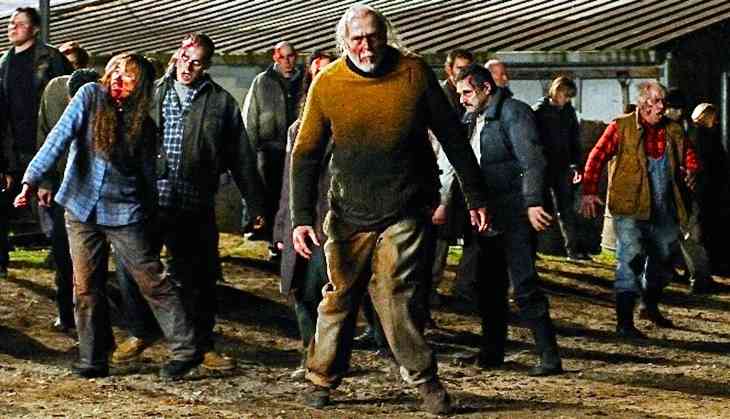George Romero’s zombies will make Americans reflect on racial violence long after his death

“What’s your zombie apocalypse survival plan?”
The question invites the liveliest discussions of the semester. I teach a course on social movements in fiction and film at West Virginia University, where I also conduct research on race and gender politics in the United States.
George Romero’s first film, “Night of the Living Dead,” is on the syllabus. The film was groundbreaking in its use of horror as political critique. Half a century later, Romero’s films are still in conversation with racial politics in the United States, and Romero’s recent death calls for reflection on his legacy as a filmmaker.
Disquieted times

Jeffrey Jerome Cohen, an English professor and monster theorist at George Washington University, notes that “Like all monsters, zombies are metaphors for that which disquiets their generative times.”
Romero shot “Night of the Living Dead” in 1967, when Americans’ attention was focused on powerful televised images of race riots in cities like Newark and Detroit, and on the Vietnam War, the likes of which were new to broadcast news. Romero reimagined scores of bleeding faces, twisted in rage or vacant from trauma, as the zombie hoard. He filtered public anger and anxieties through the hoard, reflecting what many viewed as liberals’ rage and disappointment over a lack of real social change and others saw as conservatives’ fear over disruptions in race relations and traditional family structures. This is the utility of the zombie as a political metaphor – it’s flexible; there is room enough for all our fears.
In “Night of the Living Dead,” an unlikely cross-section of people are cornered in a farmhouse by a zombie hoard. They struggle with each other and against the zombies to survive the night. At the end of the film, black protagonist Ben Huss is the sole survivor. He emerges from the basement at daybreak, only to be mistaken for a zombie and shot by an all-white militia. The militiamen congratulate each other and remark that Huss is “another one for the fire.” They never realize their terrible error. Perhaps they are inclined to see Huss as a threat to begin with, because he is black.
At the start of Romero’s next film, “Dawn of the Dead,” in which another unlikely bunch faces off against zombies in a shopping mall, police surround a public housing building. One officer remarks on the unfairness of putting blacks and Hispanics in these “big-ass fancy hotels” and proceeds to shoot residents indiscriminately, not distinguishing between the living and the undead.
The officers are shooting to restore the “natural order” in which the dead stay dead. But their actions also restore the prevailing social order and the institutions that create and reinforce racial inequality.
Zombie revival
In my class, I connect these scenes of dehumanization to contemporary racial politics, using them as a springboard for conversations about racially motivated police violence and the Black Lives Matter movement. These discussions focus on the zombie as a dehumanized creature.
In returning from the dead, zombies lose their human essence – their agency, critical reasoning capacities, empathy and language. As Cohen writes, “Zombies are a collective, a swarm. They do not own individualizing stories. They do not have personalities. They eat. They kill. They shamble. They suffer and they cause suffering. They are dirty, stinking, and poorly dressed. They are indifferent to their own decay.” Zombies retain a human form, but lose their individuality and are dehumanized in their reanimation.

Minority victims of police shootings are often portrayed in the media as dangerous, animalistic and even monstrous – meaning they too are stripped of their basic humanity. Social psychologists argue that perceptions of humanity are a critical part of social cognition – the way we process or think about other people and social settings. When we see people or groups as less than human, predictable consequences arise. Romero’s films tune us in to our own potential for dehumanization.
Zombie psychology
Dehumanization relaxes our moral restrictions on doing harm to others and ultimately facilitates violence against them. When people see members of a group as an undifferentiated “hoard,” they’re susceptible to the same error as the militiamen in “Night of the Living Dead.” When they couple dehumanization with hatred, resentment or fear, they become like the resentful police officer in “Dawn of the Dead.” Dehumanization of black Americans underpins the violence perpetrated against them in Romero’s films and in America today.
Dehumanization isn’t confined to police violence. New research shows that dehumanization of Muslims and Hispanics underlies support for restrictive immigration policies and a border wall. It also undercuts support for aid to refugees.
In my own research, I show that political candidates are often dehumanized in political discourse and campaign imagery. This work suggests that monsters plague our elections and governance processes more broadly.
![]() Romero will be best remembered for giving the zombie a place in mainstream American culture, but he also gave us a warning about human psychology and critical insights into racial politics in the U.S. For this reason, his work will continue to have a revered place on my syllabus.
Romero will be best remembered for giving the zombie a place in mainstream American culture, but he also gave us a warning about human psychology and critical insights into racial politics in the U.S. For this reason, his work will continue to have a revered place on my syllabus.
Erin C. Cassese, Associate Professor of Political Science, West Virginia University
This article was originally published on The Conversation. Read the original article.
First published: 1 August 2017, 18:49 IST
